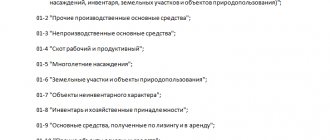Documentation of fixed asset accounting: receipt of fixed assets in the company
The rules for documenting the receipt of OS by an enterprise are not fixed in the Russian regulatory framework.
At the same time, certain provisions are contained in the law on accounting dated December 6, 2011 No. 402-FZ, as well as in the guidelines for fixed assets accounting, approved by order of the Ministry of Finance of the Russian Federation dated October 13, 2003 No. 91n. In particular, paragraph 38 of methodological instructions No. 91n explains that accounting should reflect the fact of receipt of fixed assets at the moment when the certificate of acceptance and transfer of fixed assets was signed by the head of the company.
IMPORTANT! It is indicated that such an act should be drawn up for each individual inventory item. An exception is provided only for fixed assets of the same type that have the same value, which the company takes into account at a time: in such a situation, it will be enough to draw up 1 general act for all such homogeneous fixed assets.
The legislator has not currently established any form of this act that would be mandatory for use by all companies. Since such a document is primary, the company can independently develop for its practice the form of such an act (by virtue of Article 9 of Law No. 402-FZ) or use the previously (before 01/01/2013) mandatory unified forms approved by the Decree of the State Statistics Committee of the Russian Federation dated 01/21/2003 No. 7.
This resolution contains the following forms of acts with which the company has the right to document the receipt of fixed assets:
- OS-1. This is a standard template that a company can use in relation to any newly received fixed asset with the exception of buildings (a special template is provided for them in the OS-1a form).
- OS-1b. A company can apply such a template if it takes into account not just one object, but a group of similar ones at once.
- OS-14. By an act in this form, the company can formalize the receipt at the disposal of the company (at its warehouse) of equipment that in the future (after installation) will be used as OS. The transfer of the OS for installation is formalized by an act in the OS-15 form.
IMPORTANT! Regardless of what act was used to document the receipt of the OS by the company, its acceptance into production for production should still be documented by an act according to the standard form OS-1.
After the receipt certificate has been drawn up, it, together with accompanying technical documents about the equipment, is transferred to the company’s accounting department. Accounting, in turn, opens an inventory card for each OS object (card form OS-6) or for a group of homogeneous OS objects (card form OS-6a). It is also possible to maintain an inventory book (form OS-6b).
For information about when the use of an inventory book is advisable, read the material “Unified Form No. OS-6b - Form and Sample.”
Inventory accounting of a complex object
Before disposing of part of the building, the accountant must, on the basis of an agreement, indicate the share of the disposed premises in the total value of the asset, as well as the cost of the disposed asset. The approach will depend on the method of accounting for such an item of fixed assets. The following methods can be suggested.
First way
The object is accounted for as a single inventory object, including its component parts. The share of the retiring part of the fixed asset is determined on the basis of the purchase and sale agreement and the title documents for the building. For example, the total area of a building, which is a single inventory facility, is 2000 square meters. m. According to the purchase and sale agreement, the owner of the building sells 500 sq. m. m. The share of the retiring facility will be: 500 / 2000 = 0.25 = 25%. Based on the received share, the cost of the retiring part is calculated. If the entire building costs 10 million rubles, then the disposed part will be valued at: 20 million x 25% = 2.5 million rubles. This method equalizes the cost of all floors of the building. We assume that all floors are the same.
Second way
A building is a complex object of fixed assets, consisting of individual structurally articulated objects: rooms, premises. Accounting for this object can be carried out in terms of components, for example: 1st level - the building itself with an area of 2000 square meters. m, worth 10 million rubles; The 2nd level is the 1st, 2nd, 3rd, 4th floors with an area of, say, 500 sq. m. m, costing 2.5 million rubles; Level 3 - offices (rooms) located on the 1st - 4th floors of the building, different in size, with different prices. This can be clearly seen in the table. When a part of an object is disposed of, the corresponding parts will be written off, for example: 2nd floor - rooms 20, 21, 22, 23.
Table. Accounting for a complex OS object in terms of components
| Level of detail | Name | Area, sq. m | Initial cost |
| Level 1 | Building | 2 000 | 10 000 000,00 |
| Level 2 | 1st floor | 500 | 2 500 000,00 |
| Level 3 | 11 | 240 | 1 200 000,00 |
| Level 3 | 12 | 160 | 800 000,00 |
| Level 3 | 13 | 160 | 500 000,00 |
| Level 2 | 2nd floor | 500 | 2 500 000,00 |
| Level 3 | 20 | 160 | 800 000,00 |
| Level 3 | 21 | 160 | 800 000,00 |
| Level 3 | 22 | 120 | 600 000,00 |
| Level 3 | 23 | 60 | 300 000,00 |
| Level 2 | 3rd floor | 500 | 2 500 000,00 |
| Level 3 | 31 | 200 | 1 000 000,00 |
| Level 3 | 32 | 200 | 1 000 000,00 |
| Level 3 | 33 | 100 | 500 000,00 |
| Level 2 | 4th floor | 500 | 2 500 000,00 |
| Level 3 | 41 | 180 | 900 000,00 |
| Level 3 | 42 | 180 | 900 000,00 |
| Level 3 | 43 | 40 | 200 000,00 |
| Level 3 | 44 | 100 | 500 000,00 |
The second method, of course, is more expensive for the accountant, but will allow you to easily determine the value of the retiring property in the future.
The procedure for registering the disposal of fixed assets in a company
The most common situations of disposal of fixed assets from production activity are associated with one of the following circumstances:
- the company decided to sell the OS;
- The enterprise's fixed assets are recognized as subject to write-off.
Each of the above circumstances requires specific documentation.
If a company sells its OS, then, as in the case of a purchase, it is necessary to draw up an acceptance certificate for the OS (clause 81 of guidelines No. 91n). It is drawn up according to the rules and forms described above in relation to the situation with the receipt of OS by the company. That is, if a company sells an asset that is not a building, then the act can be drawn up in the OS-1 form. If the building is being sold, then the most suitable template for the act is OS-1a. And in the case when a company simultaneously sells a group of homogeneous fixed assets, the disposal should be formalized by act OS-1b.
NOTE! The above acts should be drawn up not only in a situation where the OS is directly sold, but also when an object is transferred by a company to the authorized capital of another organization, as well as when transferred free of charge to a third party.
Such documents must be completed in any case, regardless of who the buyer is (an individual or a company). This was indicated by the Department of Tax Administration of the Russian Federation for Moscow in a letter dated May 17, 2004 No. 26-12/33266.
The second possible option is that the company’s OS is outdated, has completely served the allotted time period, or has broken down as a result of the influence of some external factors, while restoring or repairing such an OS is not economically feasible for the company. Such an OS should be decommissioned.
But for this, paragraph 77 of methodological instructions No. 91n requires the creation of a special commission of production experts who will decide whether such an OS should be written off or not.
If such a commission decides not to restore an asset, but to write it off completely, then after receiving a written decision of the commission, the company will have to document the fact of disposal of the asset with a special act. Its form, as well as according to the previously described documents, can be developed by the company independently or selected from standardized ones. In the latter case, these will be the following forms:
- OS-4 - if the company writes off one asset that is not a motor vehicle (for motor transport, form OS-4a should be used);
- OS-4b - when not one fixed asset is written off, but a group of similar ones.
After the act of disposal of the fixed assets is drawn up, the accounting specialist puts a mark on the inventory card of the object that the fixed assets have been disposed of.
Find out how to account for the sale of a fixed asset in the Typical Situation from ConsultantPlus. Study the material by getting trial access to the K+ system for free.
For information about what entries are made when disposing of fixed assets and how to calculate the retirement ratio, read the article . ”
We take into account income tax on sales
When selling fixed assets, income tax is calculated based on the residual value of the property. However, in such a situation, the residual value is calculated differently - according to the formula regulated in the letter of the Ministry of Finance of Russia dated October 9, 2012 No. 03-03-06/1/527:
Co = Sp - Am - Amp, where
- Co - the residual value of the object for calculating income tax;
- SP - the initial cost of the property;
- Am - accumulated depreciation on fixed assets;
- Amp is the depreciation bonus that was accrued on the fixed asset.
IMPORTANT!
If a company calculates depreciation not by linear, but by other methods, then the residual value should be calculated in accordance with paragraph 1 of Article 257 of the Tax Code of the Russian Federation.
The amount of depreciation bonus on fixed assets consists of additional expenses incurred for the acquisition of property, as well as the amount of financial investments aimed at modernizing or completing the facility. The amount of depreciation bonus is usually reflected in accounting as a debit to account 08 and is simultaneously accepted as an expense when calculating income tax for tax purposes. Moreover, in an amount of no more than 10-30 percent of the original price of the property.
However, if the fixed asset has been in use for less than 5 years, and the sale is carried out by an interdependent organization, then the amount of the depreciation bonus is subject to restoration and inclusion in income under the non-refundable income. Such instructions are presented in the letter of the Ministry of Finance of Russia dated December 23, 2014 No. 03-03-06/1/66590.
What are the most common errors in documenting OS movement?
In practice, there are situations when a company forgets to formalize the acceptance of OS with the appropriate act, citing the fact that the legislator has not established a mandatory form for the application of such an act.
This approach is incorrect, since since January 1, 2013, companies have been given the right to develop their own forms of accounting documents, including the form of the certificate of acceptance and transfer of fixed assets. There is no single mandatory form. But this does not mean that the act can not be drawn up. After all, if there is no act, this means that the company actually admits that the OS object is not yet ready for use.
IMPORTANT! Only after signing the acceptance and transfer certificate can the company open an inventory card for the OS object.
At the same time, in practice, some organizations violate the procedure for documenting fixed assets by first opening inventory cards (at the time the assets arrive at the company), and then only signing the act (when the OS is ready for use).
An inventory card is a document that acts as a biography for an OS object. The company maintains such a card throughout the entire service life of the OS. A new card can only be created when the object has undergone a radical modernization, as a result of which the company can no longer record all the characteristics of the OS in the old card.
Therefore, if a company reissues cards for some objects with some frequency, then these actions should also be considered erroneous.
We charge VAT on the sale of property
The sale of an organization's property is recognized in tax accounting as an ordinary sale and is therefore subject to VAT at the rate of 18%.
However, there are exceptions. If the property was used in an activity that does not fall under OSNO, and when purchasing the object, input VAT was not deducted, then when selling the fixed assets, calculate value added tax at the rate of 18/118. Moreover, an interest rate of 18/118 must be applied to the discrepancy between the price and the residual value of the fixed asset.
Such instructions are presented in the letter of the Ministry of Finance of Russia dated March 26, 2012 No. 03-07-05/08.
Results
The procedure for documenting the receipt of fixed assets into the company and the disposal of fixed assets from the company is in many ways similar: the corresponding act is signed, after which an inventory card is created or the necessary marks are put on such a card.
It is important for companies to understand: despite the fact that unified forms of acts have not been established today, the very need to prepare such documents remains. You can find more complete information on the topic in ConsultantPlus. Free trial access to the system for 2 days.
Changes
Legislative changes in the order of displaying fixed assets and business transactions with them on the balance sheet concern mainly small companies:
- Depreciation should be calculated as regularly as possible; it is important to do this at least annually. The accrual procedure must be reflected in the accounting policy.
- The company that purchased the fixed assets takes them onto its balance sheet at the NSR, to which it adds its own installation costs. The costs of transport delivery, consultations, if any, payments to intermediaries and other purchase costs can be written off immediately, without stretching them to future periods.
- If the acquired fixed assets belong to inventory (according to the classifier of fixed assets OK 013-2014), depreciation on it can be calculated immediately upon placement on the balance sheet.








